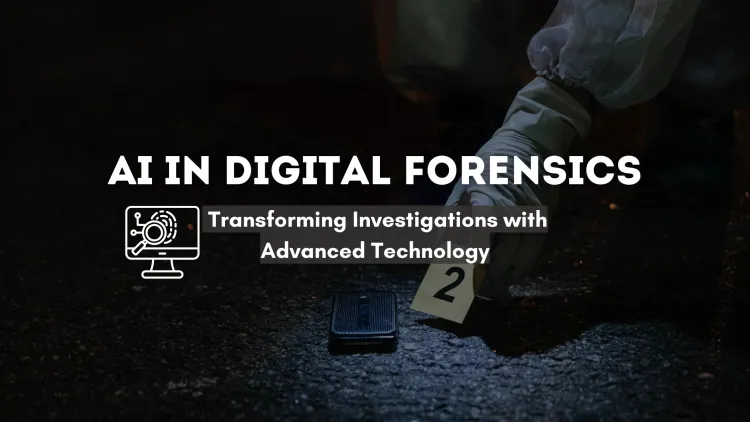Introduction
The rapid digitization of our world has created new opportunities—and new risks. Every day, cybercriminals exploit vulnerabilities in systems, launch sophisticated attacks, and cover their tracks using advanced anti-forensic techniques. At the same time, digital devices—from smartphones to IoT sensors—are producing massive amounts of data that must be examined during investigations.
Traditional digital forensics techniques, though reliable, are often slow and labor-intensive. As cases grow in scale and complexity, investigators are turning to Artificial Intelligence (AI) to speed up evidence analysis, detect hidden patterns, and enhance accuracy.
This blog explores how AI is transforming digital forensics, its benefits, applications, challenges, and the future of AI-driven forensic investigations.
Why AI in Digital Forensics?
Digital forensics involves extracting, analyzing, and interpreting data from devices or networks. With increasing case loads, investigators face challenges such as:
-
Huge volumes of data (terabytes from computers, mobiles, and servers).
-
Encrypted and obfuscated information designed to hide evidence.
-
Time constraints in solving cases and presenting admissible evidence in court.
-
Complexity of modern cybercrimes, involving multiple platforms, cloud environments, and international jurisdictions.
AI offers solutions by automating repetitive tasks, improving detection accuracy, and helping investigators focus on critical leads instead of drowning in data.
Applications of AI in Digital Forensic Investigations
-
Data Triage and Prioritization
-
AI can quickly scan massive data sets and identify files, images, or communication logs most relevant to the case.
-
For example, in child exploitation investigations, AI image recognition can flag inappropriate content among thousands of files.
-
Pattern Recognition and Anomaly Detection
-
AI models can identify unusual behavior such as abnormal logins, unauthorized access attempts, or sudden spikes in data transfers.
-
This helps investigators pinpoint the timeline of a cyberattack.
-
Natural Language Processing (NLP)
-
NLP allows forensic systems to analyze emails, chat logs, and social media conversations.
-
It helps detect suspicious keywords, threats, fraud attempts, and even sentiment in communication.
-
Image and Video Analysis
-
Malware and File Analysis
-
Machine learning models classify malware faster than manual reverse engineering.
-
AI can detect similarities between malware families, helping trace the origins of attacks.
-
Timeline Reconstruction
-
Voice and Audio Forensics
-
Fraud Detection
-
Predictive Forensics
Benefits of AI in Digital Forensics
-
Speed and Efficiency – AI reduces weeks of manual evidence review to hours.
-
Scalability – Capable of handling large datasets from multiple devices and sources.
-
Accuracy – Machine learning models minimize human error and bias.
-
Proactive Detection – AI not only investigates past incidents but can also predict future risks.
-
Resource Optimization – Investigators can focus on high-level analysis while AI handles repetitive tasks.
Real-World Examples
-
Law Enforcement
-
Cybersecurity Incidents
-
Financial Forensics
-
Court Evidence Analysis
Challenges of AI in Digital Forensics
While AI is promising, it comes with limitations:
-
Bias in AI Models
-
Explainability Issues
-
Data Privacy Concerns
-
Adversarial Attacks
-
Legal Admissibility
-
High Costs
Best Practices for Using AI in Digital Forensics
-
Human Oversight – AI should support, not replace, forensic examiners.
-
Regular Model Training – Keep AI models updated with fresh data.
-
Ethical Usage – Maintain privacy, consent, and legal compliance.
-
Transparency – Document how AI tools were used in investigations.
-
Multi-Tool Verification – Use AI results alongside traditional forensic methods for stronger evidence.
Conclusion
Artificial Intelligence is revolutionizing digital forensic investigations. By automating data analysis, detecting anomalies, and reconstructing events, AI empowers investigators to solve cases faster and more accurately. However, ethical concerns, transparency issues, and legal challenges remain barriers to full adoption.
The future of digital forensics lies in human-AI collaboration—where machine intelligence accelerates the process, and human expertise ensures accuracy, context, and fairness.
As cybercrime grows more sophisticated, AI will be the critical ally that ensures forensic science continues to deliver justice in the digital age.





Post comments (0)